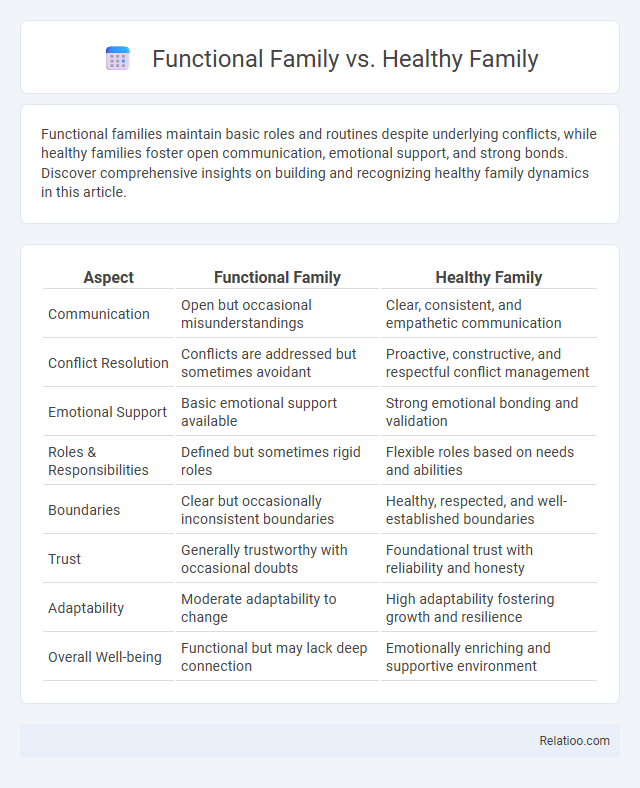Functional families maintain basic roles and routines despite underlying conflicts, while healthy families foster open communication, emotional support, and strong bonds. Discover comprehensive insights on building and recognizing healthy family dynamics in this article.
Table of Comparison
| Aspect | Functional Family | Healthy Family |
|---|---|---|
| Communication | Open but occasional misunderstandings | Clear, consistent, and empathetic communication |
| Conflict Resolution | Conflicts are addressed but sometimes avoidant | Proactive, constructive, and respectful conflict management |
| Emotional Support | Basic emotional support available | Strong emotional bonding and validation |
| Roles & Responsibilities | Defined but sometimes rigid roles | Flexible roles based on needs and abilities |
| Boundaries | Clear but occasionally inconsistent boundaries | Healthy, respected, and well-established boundaries |
| Trust | Generally trustworthy with occasional doubts | Foundational trust with reliability and honesty |
| Adaptability | Moderate adaptability to change | High adaptability fostering growth and resilience |
| Overall Well-being | Functional but may lack deep connection | Emotionally enriching and supportive environment |
Defining Functional and Healthy Families
Functional families maintain effective communication, establish clear roles, and support individual growth, promoting stability and resilience. Healthy families emphasize emotional well-being, demonstrate empathy, and nurture strong interpersonal connections that enhance trust and security. Both functional and healthy families contribute to optimal development but differ in focus; functionality prioritizes structure and adaptability, whereas health centers on emotional connectedness and psychological wellness.
Core Characteristics of Functional Families
Functional families maintain clear communication, mutual respect, and effective problem-solving skills, fostering emotional support and stability. Healthy families share similar traits but emphasize emotional warmth, flexibility, and nurturing environments that promote individual growth. Recognizing these core characteristics helps you cultivate a supportive and balanced family dynamic that encourages well-being and resilience.
What Makes a Family Healthy?
A healthy family is characterized by open communication, mutual respect, and emotional support among its members, creating a nurturing environment where everyone feels valued. While a functional family manages daily responsibilities effectively, a healthy family takes it further by fostering trust, empathy, and secure attachments that promote overall well-being. Your family's health depends on consistent positive interactions and the ability to resolve conflicts constructively, ensuring long-term emotional resilience.
Communication Patterns: Functional vs Healthy
Functional families maintain communication patterns that prioritize clarity and problem-solving, ensuring members effectively convey needs and concerns without escalating conflict. Healthy families exhibit open, empathetic communication, fostering emotional support and mutual understanding that strengthens relational bonds. Unlike merely functional families, healthy families emphasize active listening and validation, creating a safe space for authentic expression and emotional growth.
Boundaries and Roles in Family Systems
Functional families establish clear boundaries and well-defined roles that promote respect and individual autonomy, ensuring each member understands their responsibilities within the family system. Healthy families maintain flexible boundaries and adaptive roles, allowing for open communication, emotional support, and growth while balancing individual needs with family cohesion. Dysfunctional families exhibit rigid or diffuse boundaries along with poorly defined or conflicting roles, leading to confusion, enmeshment, or disengagement that disrupts healthy family functioning.
Conflict Resolution Strategies
Functional families utilize effective conflict resolution strategies such as active listening, clear communication, and compromise to maintain stability and support emotional growth. Healthy families demonstrate advanced conflict resolution by fostering empathy, mutual respect, and collaborative problem-solving, which strengthens relationships and promotes long-term harmony. In contrast, dysfunctional families often lack constructive conflict resolution skills, leading to frequent misunderstandings, unresolved disputes, and emotional disconnection.
Emotional Support and Security
Emotional support and security distinguish healthy families by fostering open communication, trust, and consistent nurturing, which promote resilience and well-being for all members. Functional families maintain basic roles and responsibilities but may lack the depth of emotional connection and reassurance provided by healthy families. Dysfunctional families often experience emotional neglect, insecurity, and inconsistent support, leading to unresolved conflicts and diminished emotional stability.
Impact on Child Development
Functional families provide consistent routines and clear boundaries that foster a child's emotional security and social skills, while healthy families emphasize open communication and emotional support, promoting resilience and self-esteem. Dysfunctional families often expose children to neglect or conflict, increasing the risk of behavioral problems and developmental delays. Your child's growth thrives best in environments where stability, nurturing interactions, and positive role models are present.
Signs of Dysfunction: Red Flags to Watch
Signs of dysfunction in families often include poor communication, constant conflict, and lack of emotional support, distinguishing dysfunctional families from healthy or functional ones. Healthy families exhibit clear boundaries, mutual respect, and effective conflict resolution, whereas functional families may function adequately but sometimes struggle with consistency or deeper emotional connection. Red flags such as avoidance of problems, unresolved resentments, and neglect of individual needs highlight the presence of dysfunction, signaling a need for intervention or therapy.
Building a Functional and Healthy Family Structure
Building a functional and healthy family structure involves establishing clear communication, mutual respect, and emotional support among all members. Functional families effectively manage conflicts and responsibilities, fostering a stable environment where each member feels valued and understood. Prioritizing empathy and consistent positive interactions strengthens family bonds and promotes overall well-being.

Infographic: Functional Family vs Healthy Family
 relatioo.com
relatioo.com